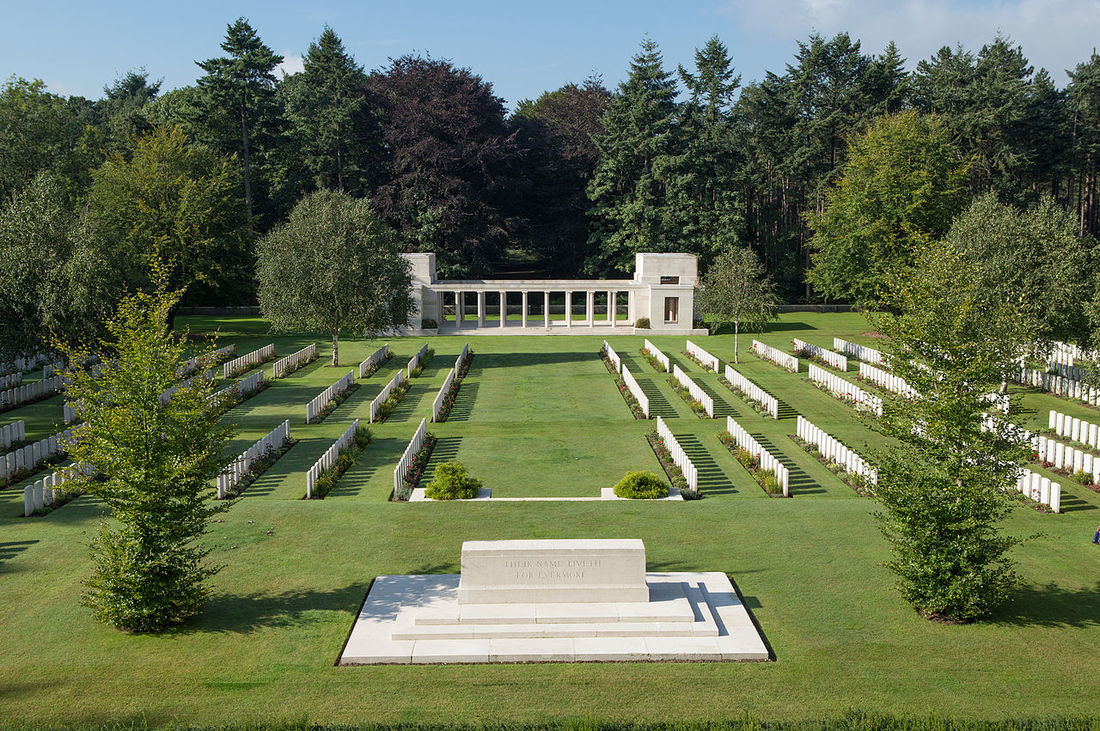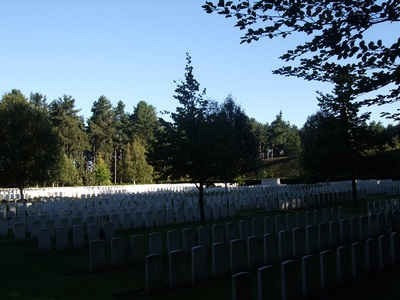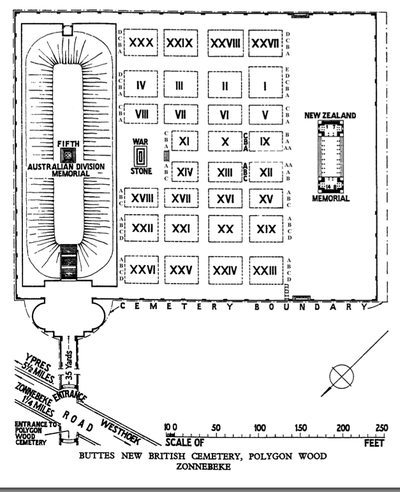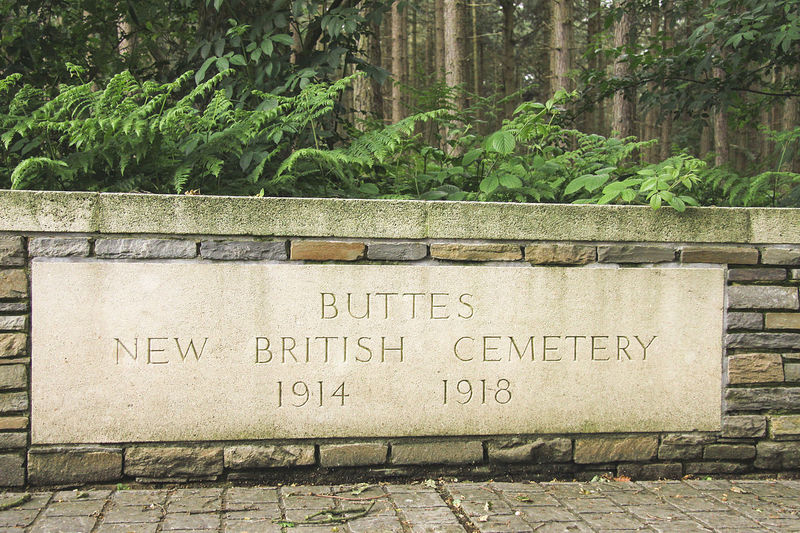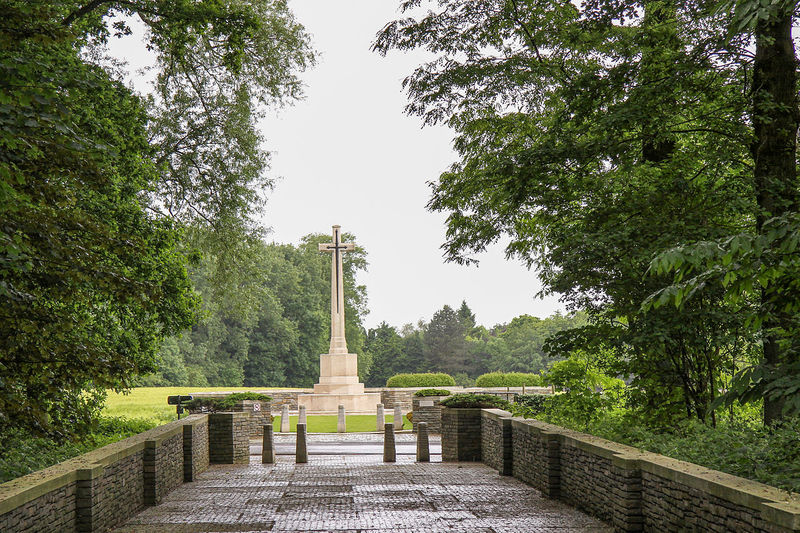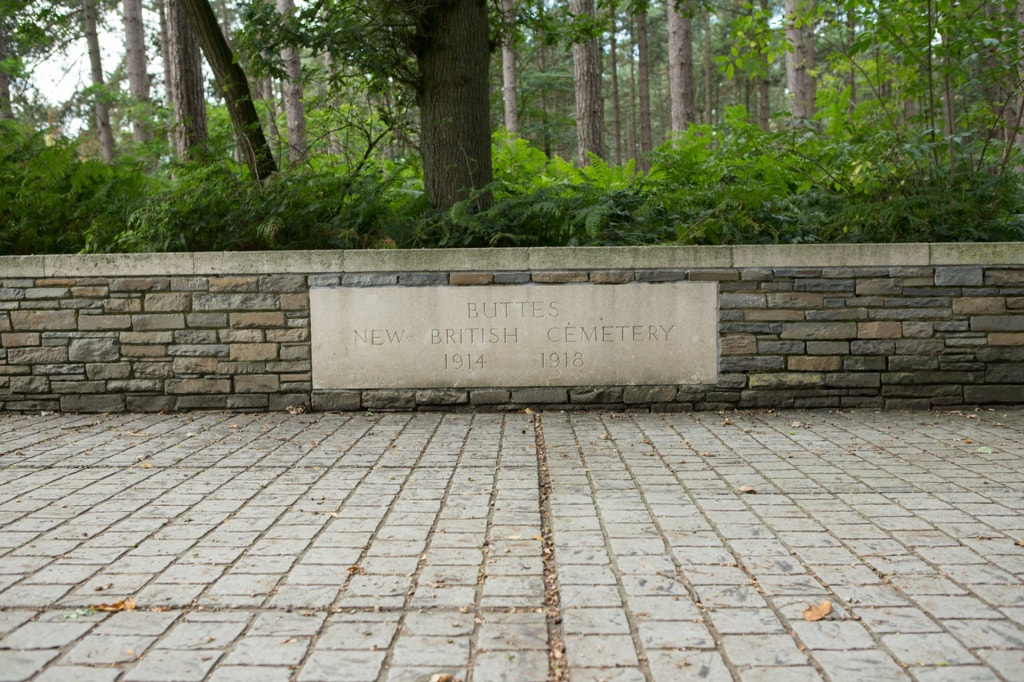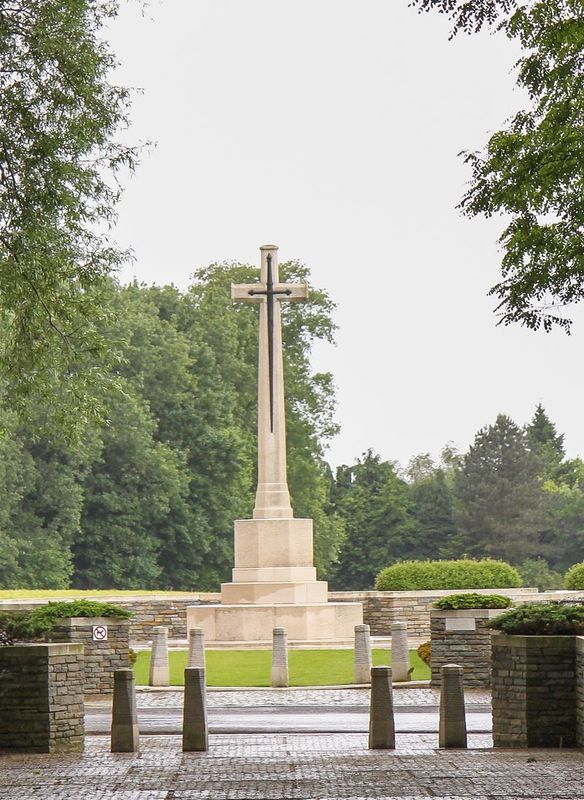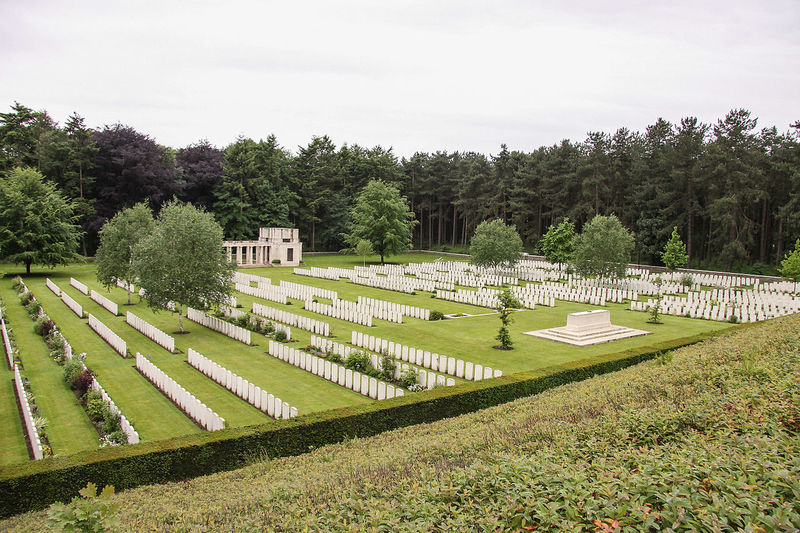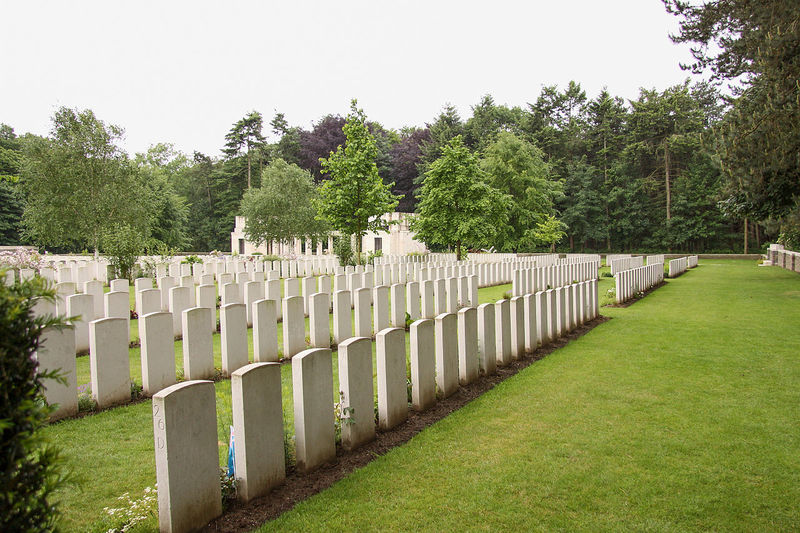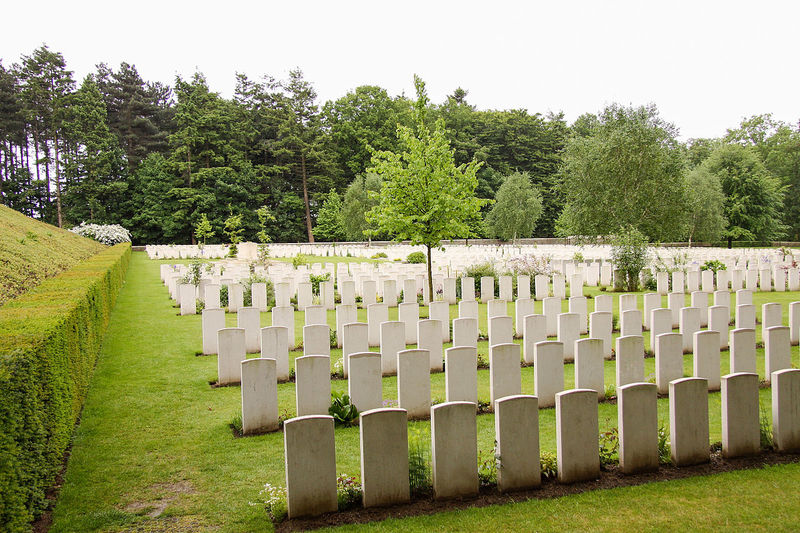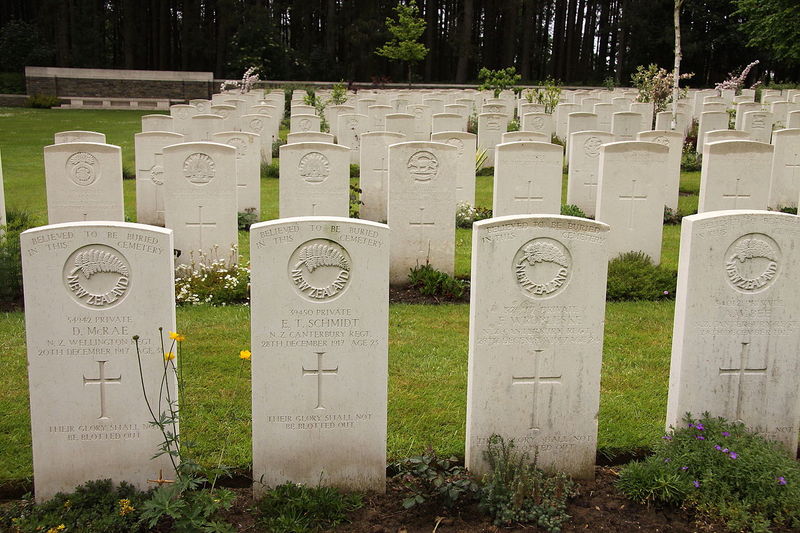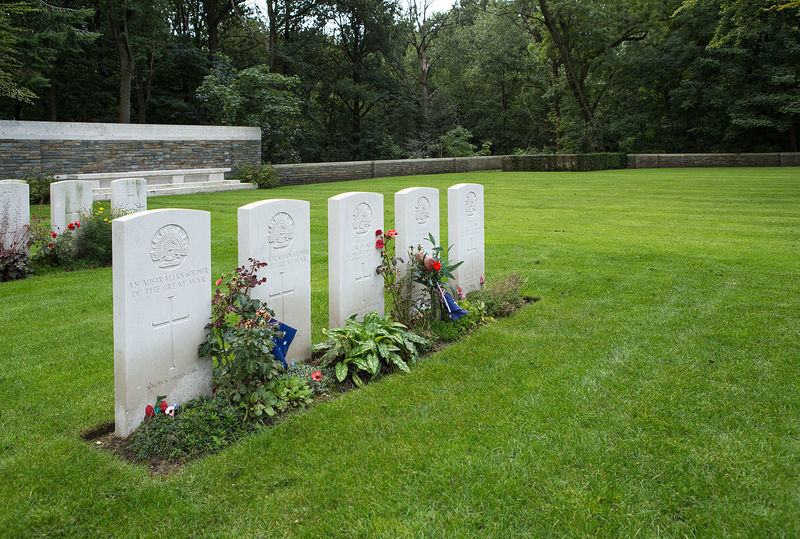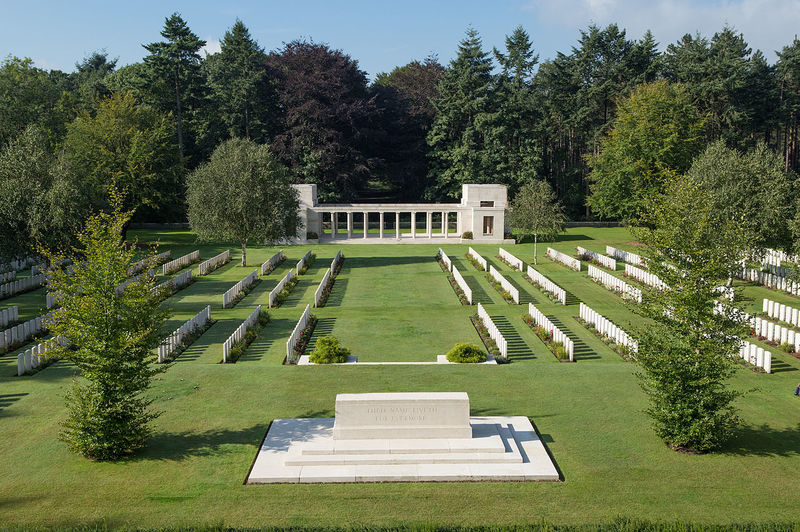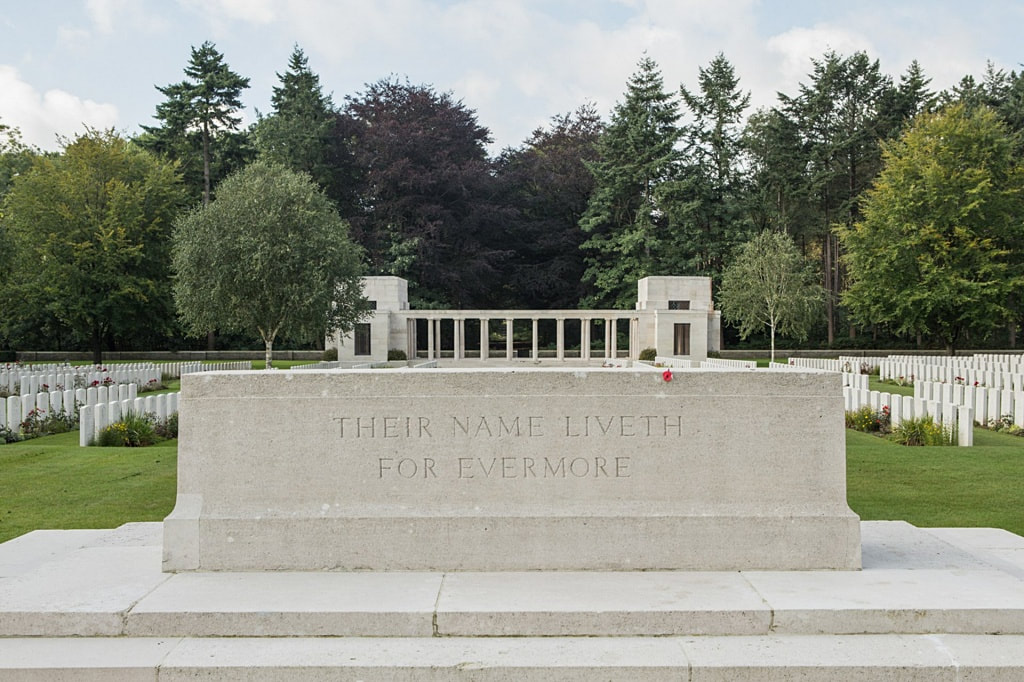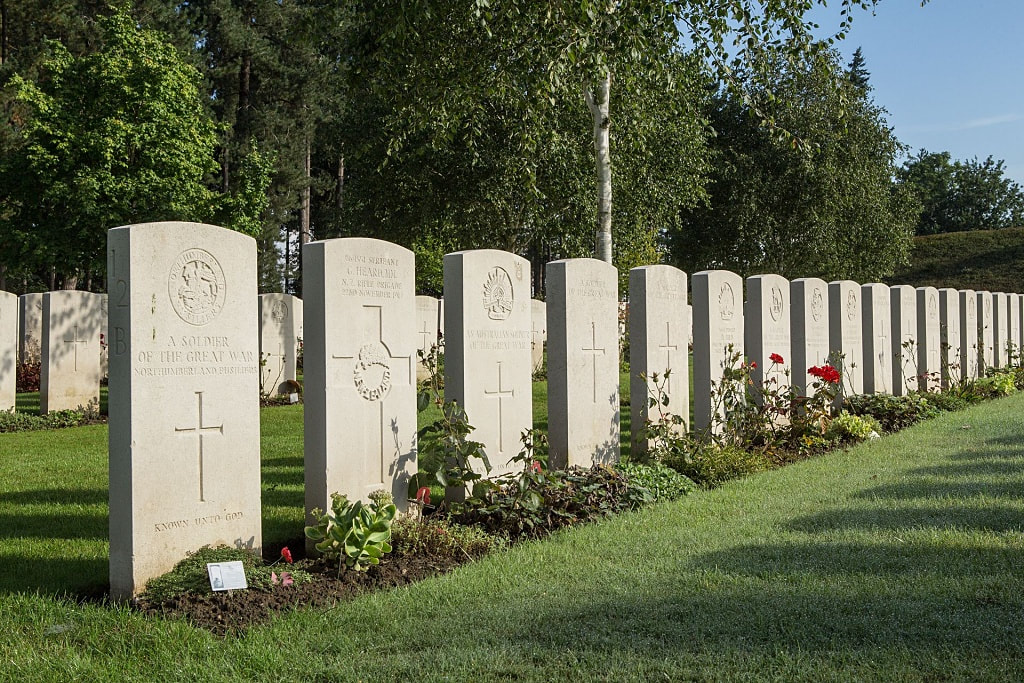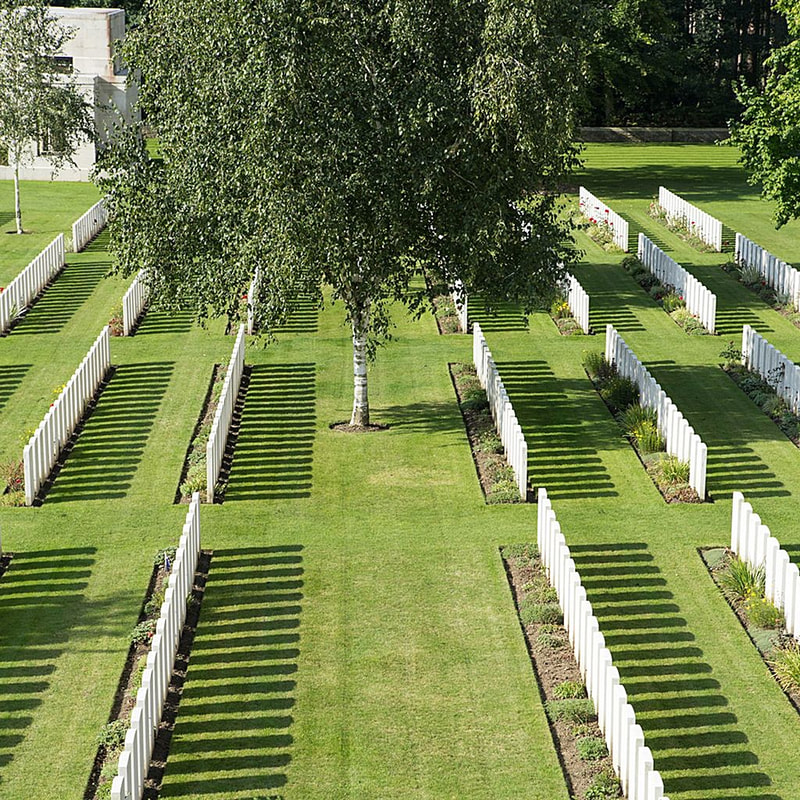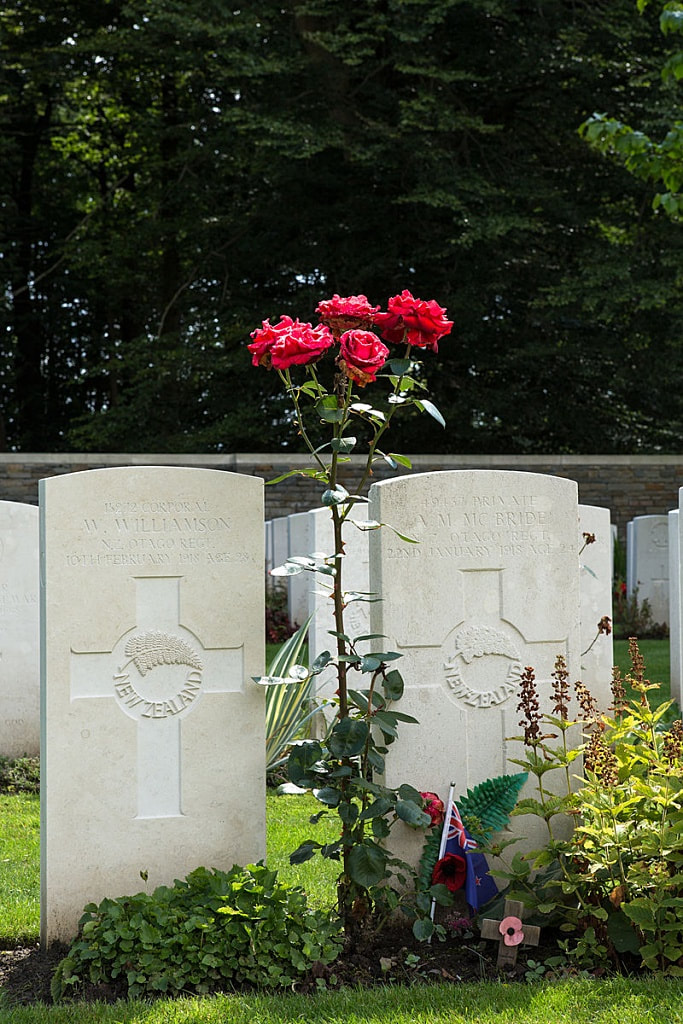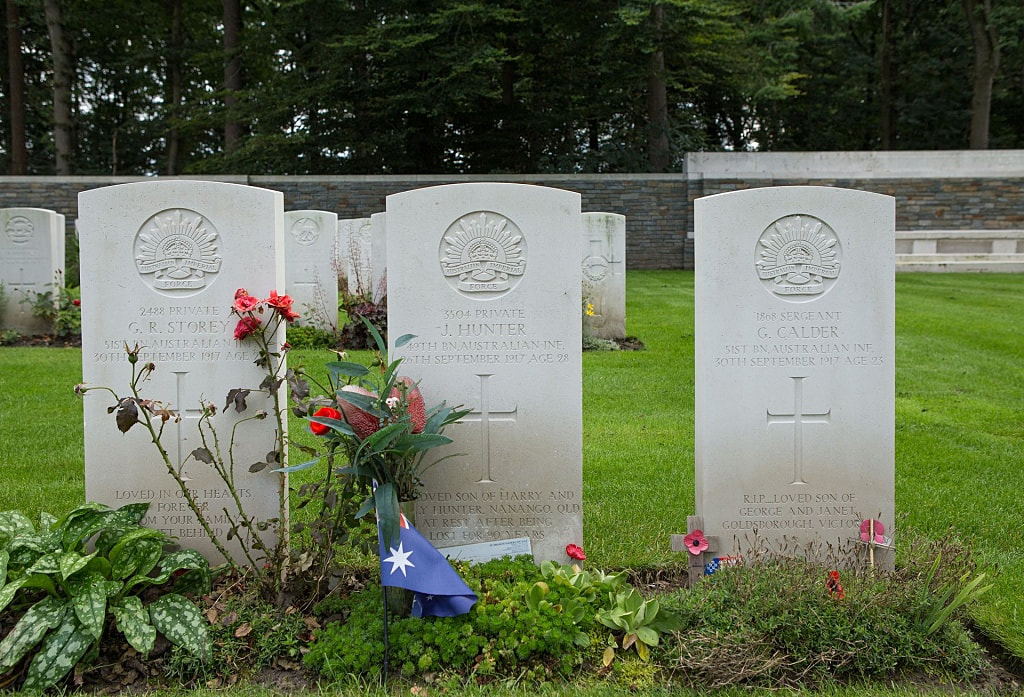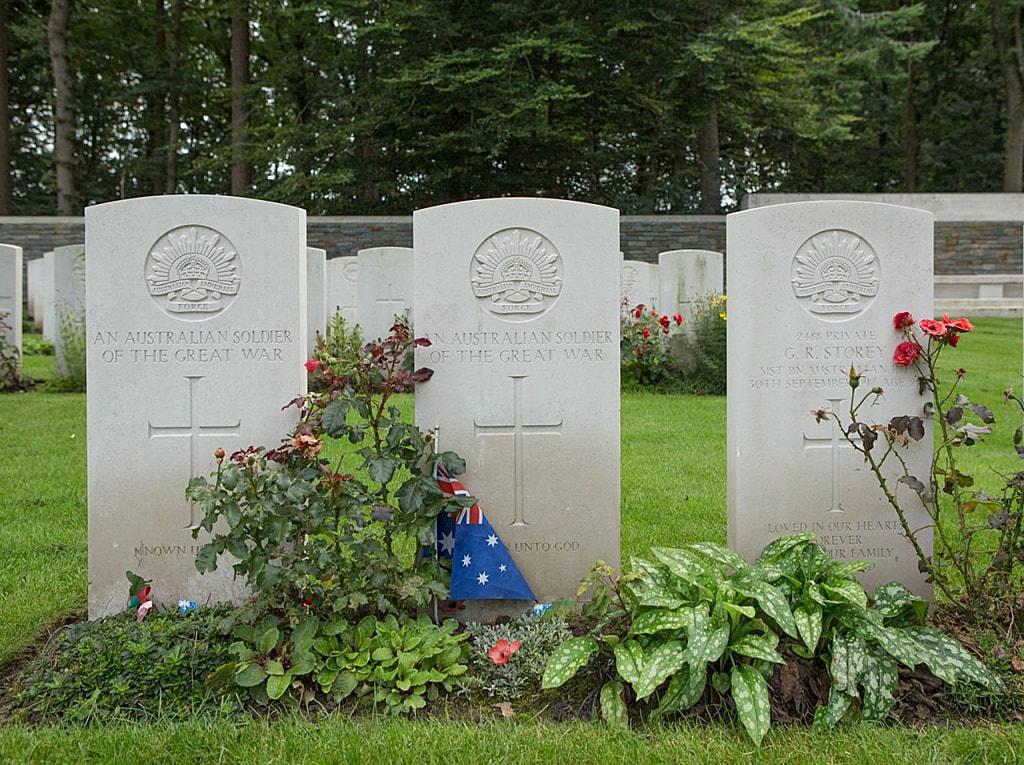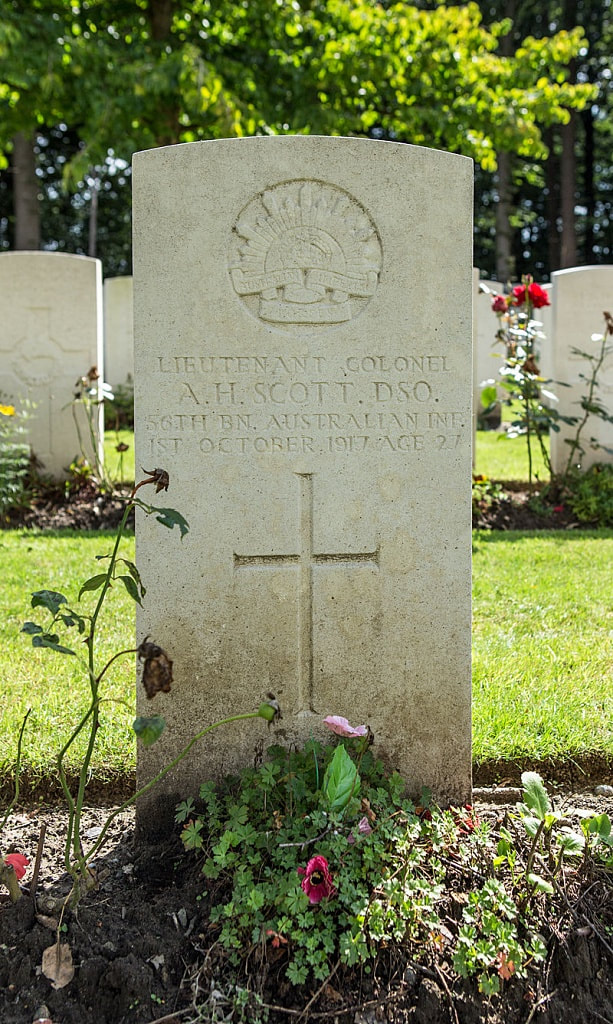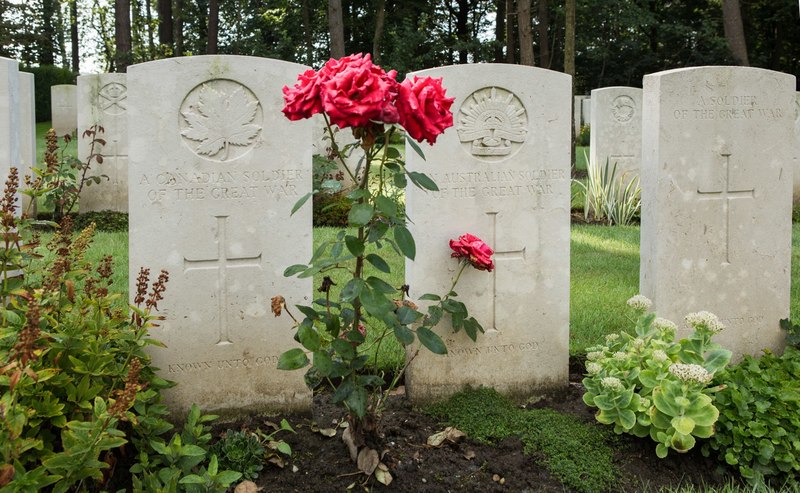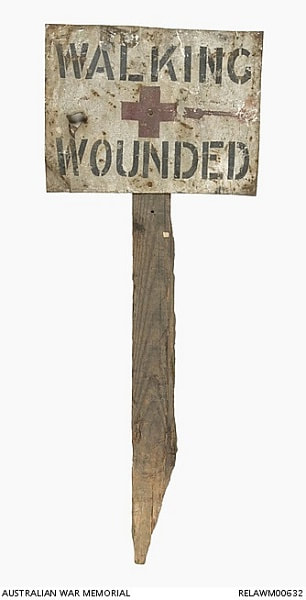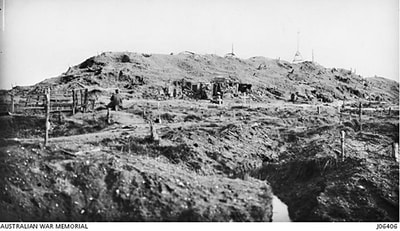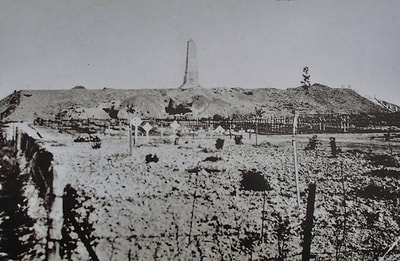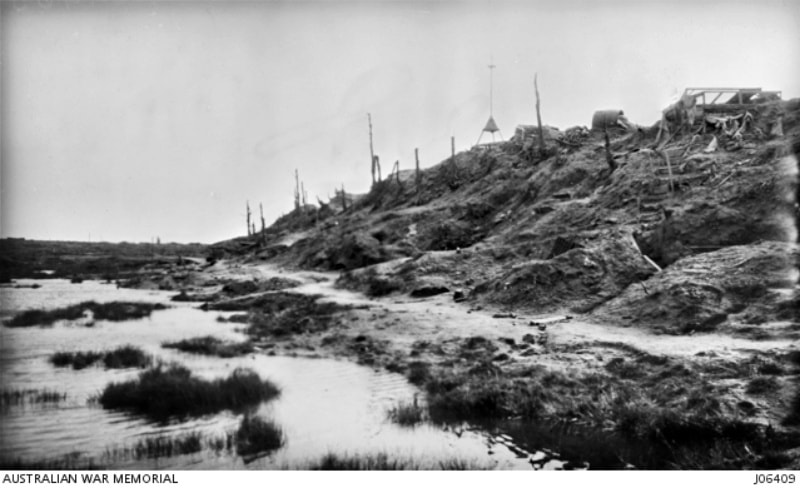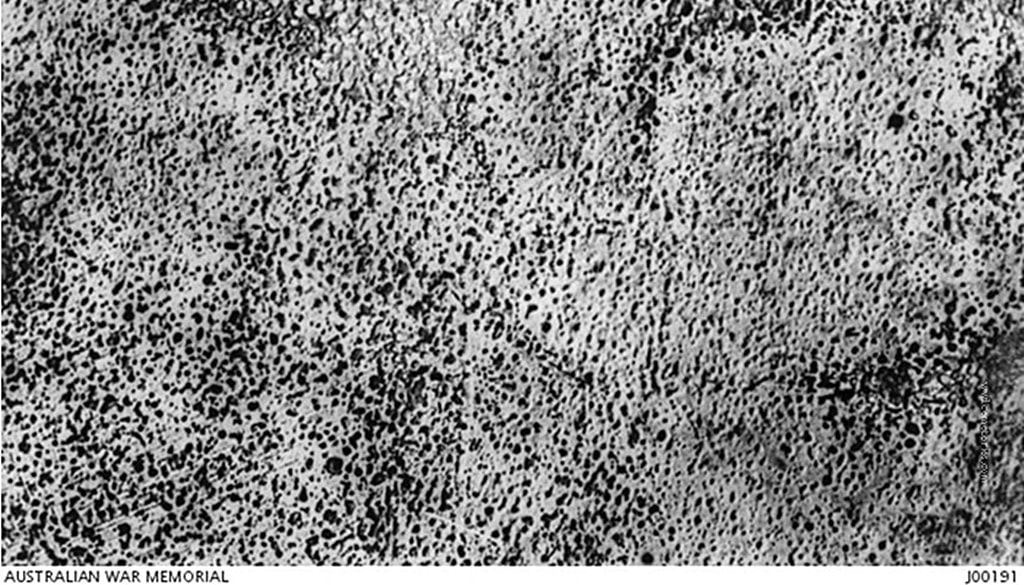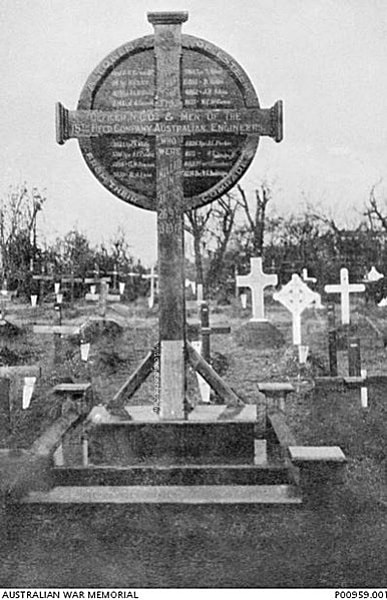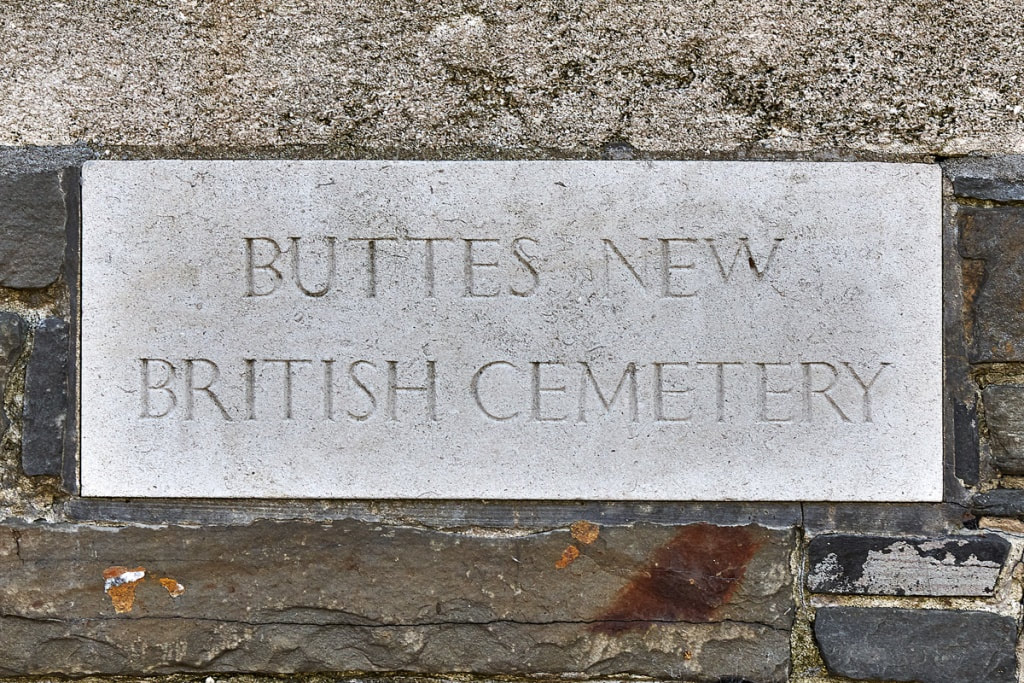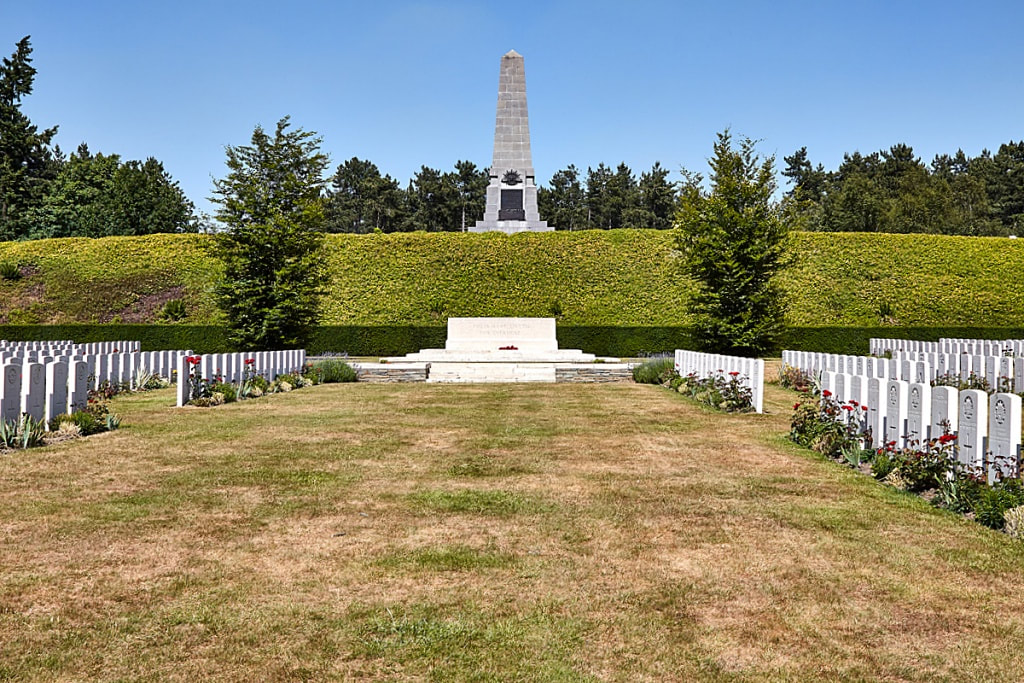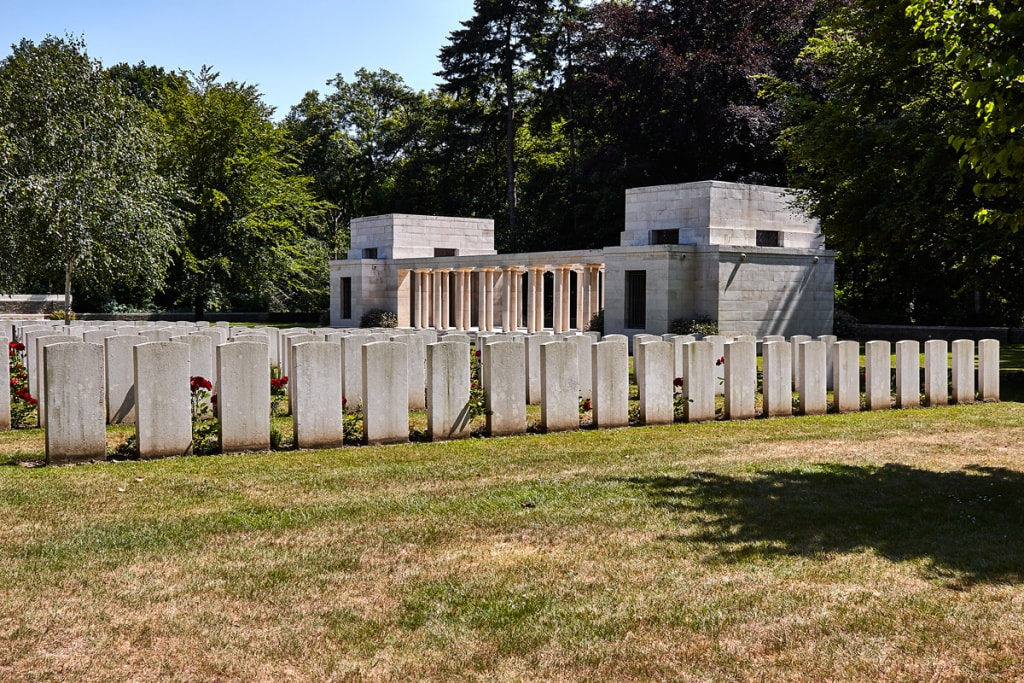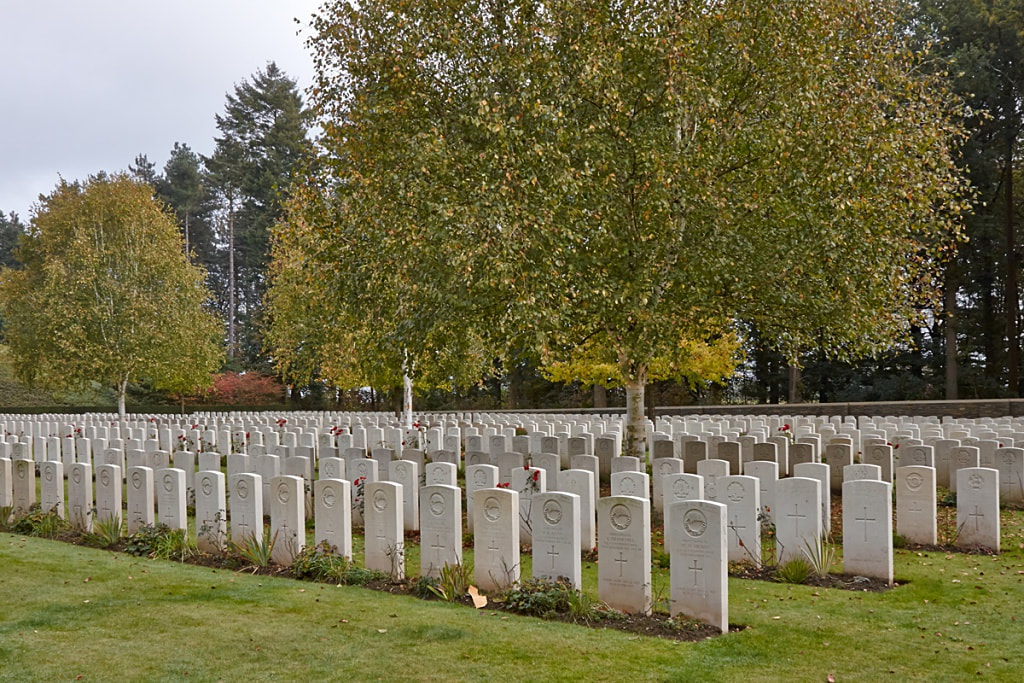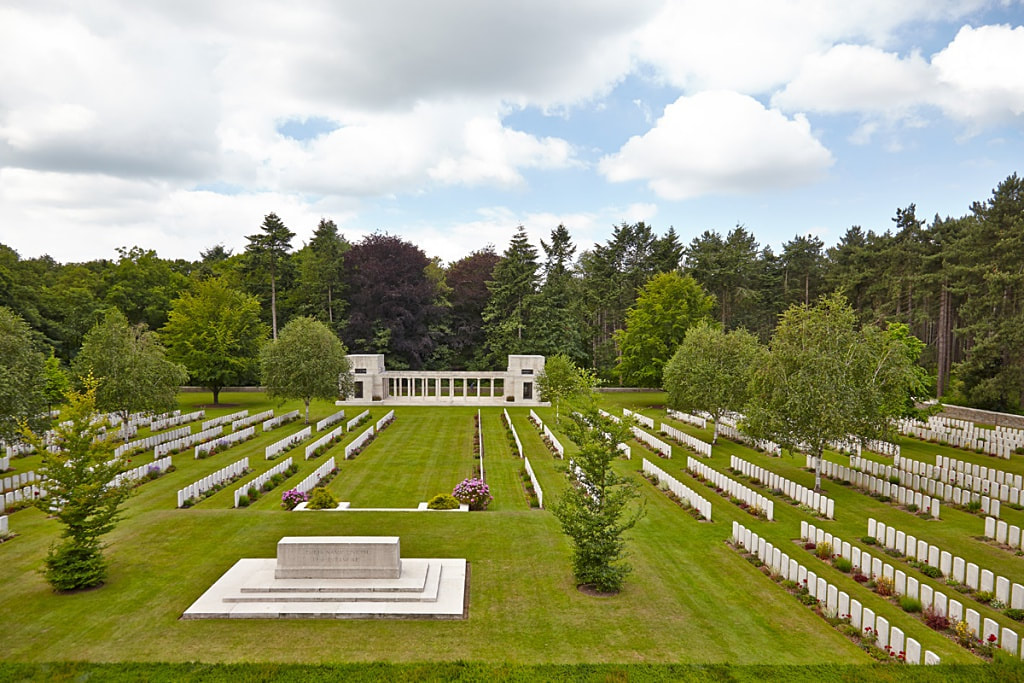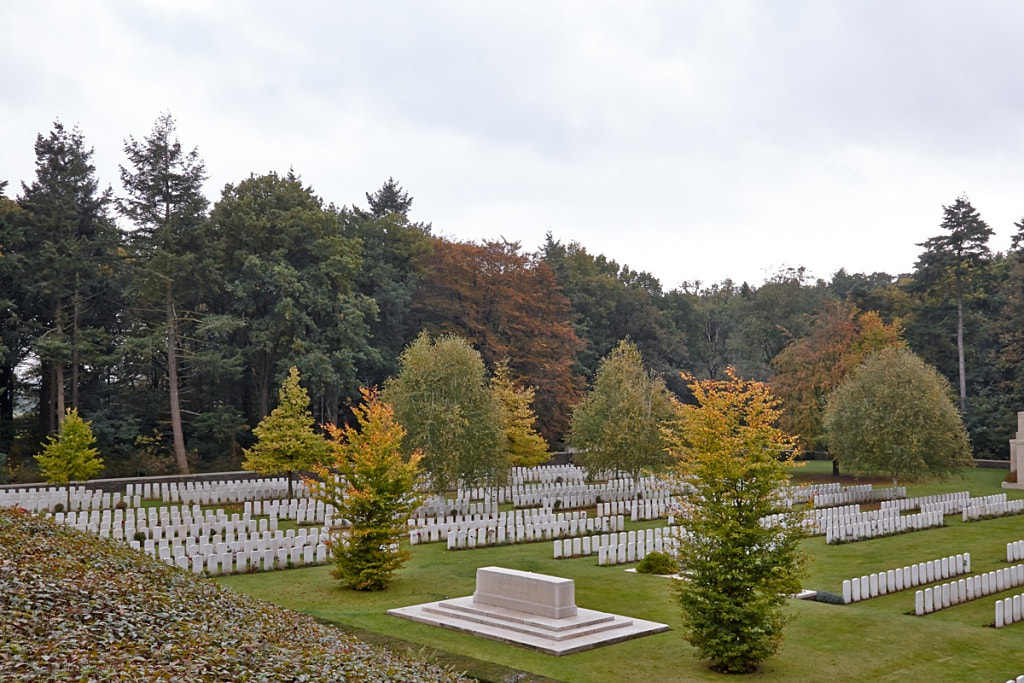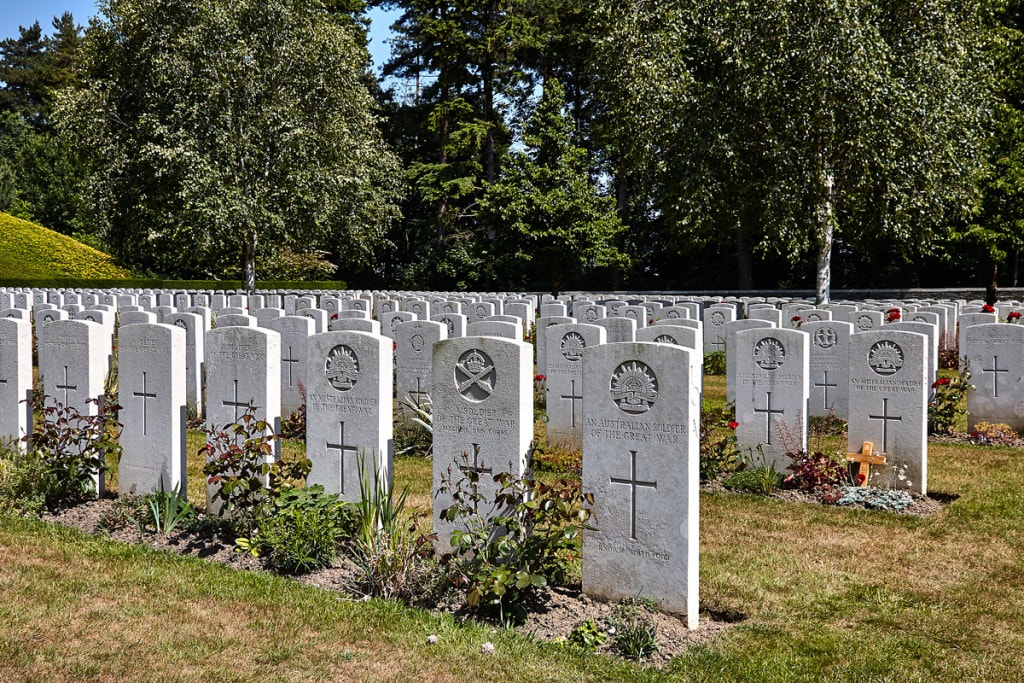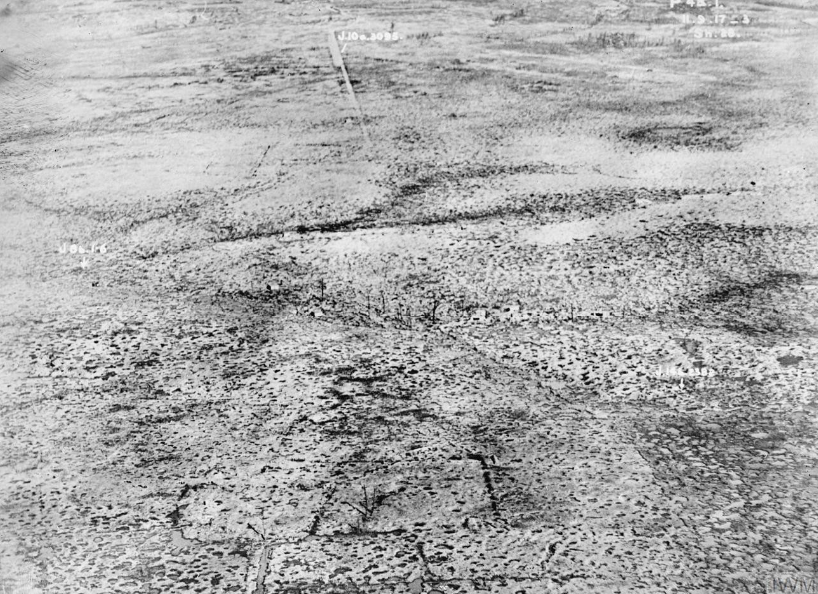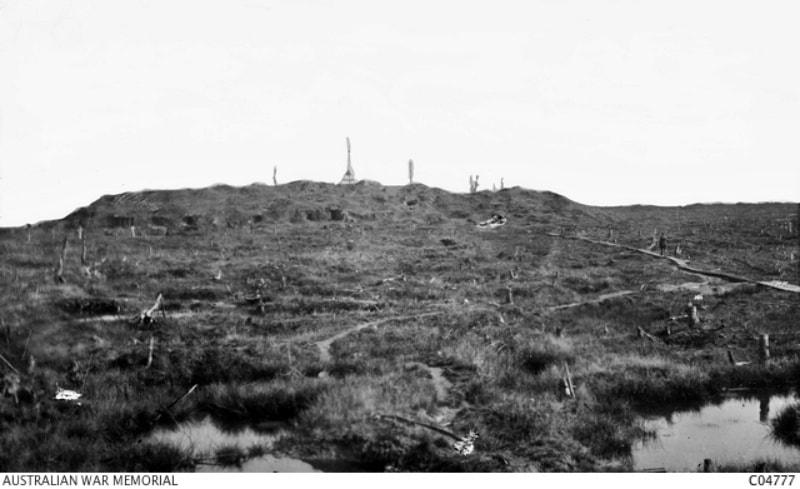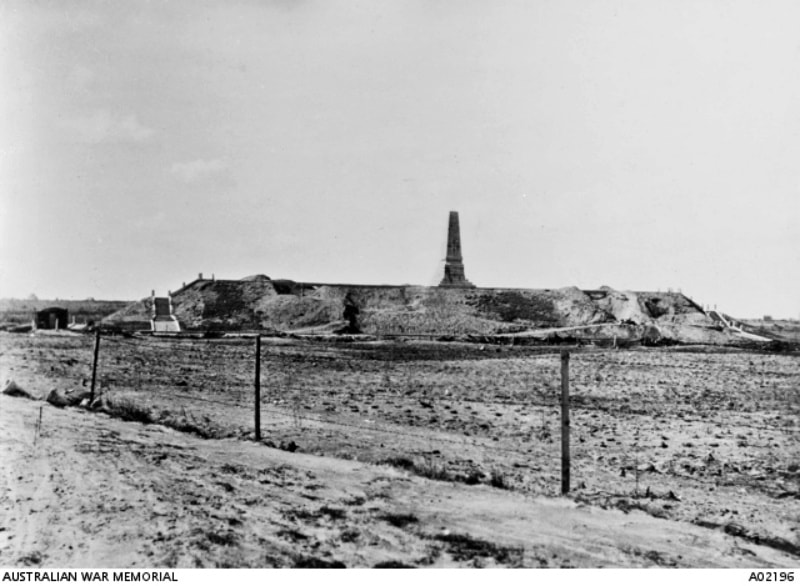BUTTES NEW BRITISH CEMETERY
Polygon Wood
West-Vlaanderen
Belgium
GPS Coordinates Latitude: 50.85694 Longitude: 2.99084
Location Information
Buttes New British Cemetery is located 8 Kms east of Ieper town centre on the Lange Dreve, a road leading from the Meenseweg (N8) connecting Ieper to Menen.
From Ieper town centre the Meenseweg is located via Torhoutstraat and right onto Basculestraat. Basculestraat ends at a main crossroads, directly over which begins the Meenseweg. 4.7 Kms along the Meenseweg, after the Bellewaerde theme park, lies the left hand turning onto Oude Kortrijkstraat. 2 Kms along the Oude Kortrijkstraat the road crosses the A19 motorway. Immediately after this bridge is the left hand turning onto the Lotegatstraat, which borders Polygon Wood. 800 meters along the Lotegatstraat is the right hand turning onto Lange Dreve. The Cemetery is located 1 Km along the Lange Dreve on the right hand side of the road.
Visiting Information
Wheelchair access is possible via the main entrance.
Historical Information
Polygon Wood (the "Polygone de Zonnebeke", or Polygoneveld)is a large wood south of the village of Zonnebeke which was completely devastated in the First World War. The wood was cleared by Commonwealth troops at the end of October 1914, given up on 3 May 1915, taken again at the end of September 1917 by Australian troops, evacuated in the Battles of the Lys, and finally retaken by the 9th (Scottish) Division on 28 September 1918. On the Butte itself is the Battle Memorial of the 5th Australian Division, who captured it on 26 September 1917.
POLYGON WOOD CEMETERY is an irregular front-line cemetery made between August 1917 and April 1918, and used again in September 1918.
Total Burials: 108.
Identified Caualties: New Zealand 58, United Kingdom 30, Germany 1. Total 89.
Unidentified Casualties: 18. Total 19.
A walled avenue leads from Polygon Wood Cemetery, past the Cross of Sacrifice, to the BUTTES NEW BRITISH CEMETERY. This burial ground was made after the Armistice when a large number of graves (almost all of 1917, but in a few instances of 1914, 1916 and 1918) were brought in from the battlefields of Zonnebeke.
There are now 2,108 Commonwealth servicemen of the First World War buried or commemorated in Buttes New British Cemetery. 1,677 of the burials are unidentified but special memorials are erected to 35 casualties known or believed to be buried among them.
Total Burials: 2,108.
Identified Burials: United Kingdom 170, Australia 160, New Zealand 95, Canada 6. Total 431.
Unidentified Burials: 1,677.
The BUTTES NEW BRITISH CEMETERY (NEW ZEALAND) MEMORIAL, which stands in Buttes New British Cemetery, commemorates 378 officers and men of the New Zealand Division who died in the Polygon Wood sector between September 1917 and May 1918, and who have no known grave.
Commemorated: New Zealand 378. Total 378.
The 5th Australian Memorial is also located in the cemetery
The cemeteries and memorial were designed by Charles Holden and Captain Wilfred Clement Von Berg, M. C.
Buttes New British Cemetery is located 8 Kms east of Ieper town centre on the Lange Dreve, a road leading from the Meenseweg (N8) connecting Ieper to Menen.
From Ieper town centre the Meenseweg is located via Torhoutstraat and right onto Basculestraat. Basculestraat ends at a main crossroads, directly over which begins the Meenseweg. 4.7 Kms along the Meenseweg, after the Bellewaerde theme park, lies the left hand turning onto Oude Kortrijkstraat. 2 Kms along the Oude Kortrijkstraat the road crosses the A19 motorway. Immediately after this bridge is the left hand turning onto the Lotegatstraat, which borders Polygon Wood. 800 meters along the Lotegatstraat is the right hand turning onto Lange Dreve. The Cemetery is located 1 Km along the Lange Dreve on the right hand side of the road.
Visiting Information
Wheelchair access is possible via the main entrance.
Historical Information
Polygon Wood (the "Polygone de Zonnebeke", or Polygoneveld)is a large wood south of the village of Zonnebeke which was completely devastated in the First World War. The wood was cleared by Commonwealth troops at the end of October 1914, given up on 3 May 1915, taken again at the end of September 1917 by Australian troops, evacuated in the Battles of the Lys, and finally retaken by the 9th (Scottish) Division on 28 September 1918. On the Butte itself is the Battle Memorial of the 5th Australian Division, who captured it on 26 September 1917.
POLYGON WOOD CEMETERY is an irregular front-line cemetery made between August 1917 and April 1918, and used again in September 1918.
Total Burials: 108.
Identified Caualties: New Zealand 58, United Kingdom 30, Germany 1. Total 89.
Unidentified Casualties: 18. Total 19.
A walled avenue leads from Polygon Wood Cemetery, past the Cross of Sacrifice, to the BUTTES NEW BRITISH CEMETERY. This burial ground was made after the Armistice when a large number of graves (almost all of 1917, but in a few instances of 1914, 1916 and 1918) were brought in from the battlefields of Zonnebeke.
There are now 2,108 Commonwealth servicemen of the First World War buried or commemorated in Buttes New British Cemetery. 1,677 of the burials are unidentified but special memorials are erected to 35 casualties known or believed to be buried among them.
Total Burials: 2,108.
Identified Burials: United Kingdom 170, Australia 160, New Zealand 95, Canada 6. Total 431.
Unidentified Burials: 1,677.
The BUTTES NEW BRITISH CEMETERY (NEW ZEALAND) MEMORIAL, which stands in Buttes New British Cemetery, commemorates 378 officers and men of the New Zealand Division who died in the Polygon Wood sector between September 1917 and May 1918, and who have no known grave.
Commemorated: New Zealand 378. Total 378.
The 5th Australian Memorial is also located in the cemetery
The cemeteries and memorial were designed by Charles Holden and Captain Wilfred Clement Von Berg, M. C.
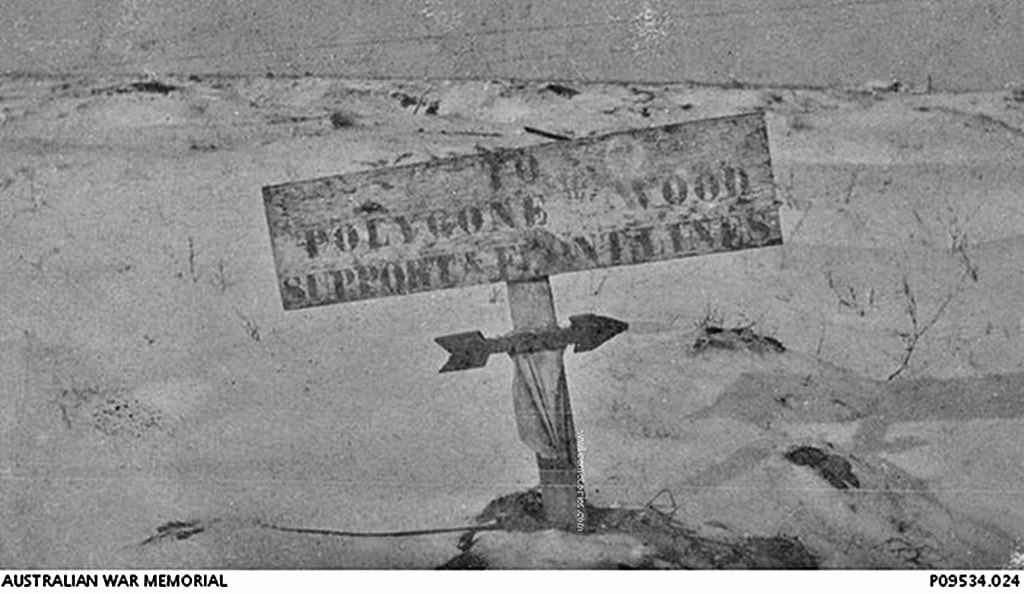
This photo was inscribed with "Phil Hall was buried somewhere near here." 'This was a cousin of Lt Harvey.' The sign in the snow reads 'TO POLYGONE [sic] WOOD. SUPPPORT & FRONT LINES.' Phil Hall is probably 3796 Private (Pte) William Philip Hall, 29th Battalion, of Geelong, Vic. He was killed in action on 26 September 1917 and buried in Polygon Wood Race Course. He was later re-buried in Duhallow A D S Cemetery, Belgium. (One of a collection of photographs belonging to Lieutenant (Lt) Robert Trevor Williams and taken by Lt William Wyatt Harvey during a battlefield tour of France and Belgium, January 1919, by officers of the 3rd Pioneer Battalion. The original caption quoted in double inverted commas is by Lt Harvey. The original caption quoted in single inverted commas is by Lt Williams.)
Images in this gallery © Werner Van Caneghem
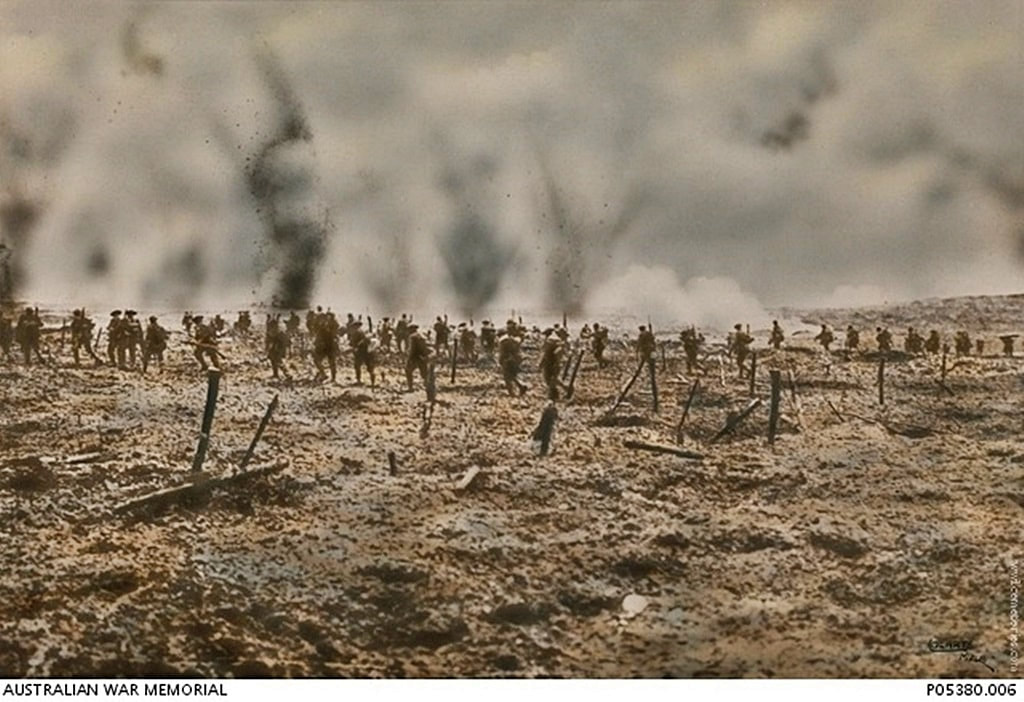
c 1921. "Following the barrage, 20th September, 1917". A hand-coloured print of a photograph taken by an unknown Australian soldier showing the attack on Polygon Wood by the Australian troops that followed a great barrage on the morning of 20 September 1917. This hand-coloured print was produced by Colarts Studio, also known as the Colograph-Art Company. Colarts was the contractor to the Australian War Memorial for producing photographic prints for sale to the public. The studio produced enlargements, intended for framing, and toned and hand-coloured prints. Joynt also collected soldier photographs, from which he produced, exhibited, and sold similar coloured enlargements. Colarts was owned by Capt. William D. Joynt, V.C. Colarts Studio operated at 98 Albert St, Windsor, Melbourne, then 447-9 Law Courts Place, Melbourne. The entry for this print in Colarts' catalogue of soldier photographs carried the following caption: "The Passchendaele operations saw the greatest concentration of artillery in the war - one gun to every nine years of front - throwing projectiles weighing from 18 lbs. to nearly a ton, to a depth of 1000 yards. Advancing in lifts of 100 yards every three minutes, our men literally walked behind a wall of fire". This print was made in Colarts' Windsor studio. Joynt's collection of soldier photographs was later acquired by the AWM.

3365 Private
John Samuel Bell
50th Bn. Australian Infantry, A. I. F.
22nd June 1917, aged 22.
Plot XXVI. A. 17.
Son of Francis John Patterson Bell and Elizabeth Hannah Bell. Native of McLaren Vale, South Australia.
A 21 year old labourer prior to enlisting on 12 December 1916, he embarked for overseas with the 9th Reinforcements of the 50th Battalion from Adelaide on 10 February 1917 aboard HMAT Seang Bee. Following further training in England, he proceeded to Belgium where he joined the 50th Battalion on 21 September 1917. Five days later, he was killed in action at Passchendaele on 26 September 1917 and buried in the Buttes New British Cemetery, Polygon Wood, Zonnebeke, Belgium. His older brother, 4733 Pte Roderick James Bell also served with the 50th Battalion and was killed in action at Messines, Belgium and is commemorated on the Menin Gate Memorial at Ypres, Belgium.
John Samuel Bell
50th Bn. Australian Infantry, A. I. F.
22nd June 1917, aged 22.
Plot XXVI. A. 17.
Son of Francis John Patterson Bell and Elizabeth Hannah Bell. Native of McLaren Vale, South Australia.
A 21 year old labourer prior to enlisting on 12 December 1916, he embarked for overseas with the 9th Reinforcements of the 50th Battalion from Adelaide on 10 February 1917 aboard HMAT Seang Bee. Following further training in England, he proceeded to Belgium where he joined the 50th Battalion on 21 September 1917. Five days later, he was killed in action at Passchendaele on 26 September 1917 and buried in the Buttes New British Cemetery, Polygon Wood, Zonnebeke, Belgium. His older brother, 4733 Pte Roderick James Bell also served with the 50th Battalion and was killed in action at Messines, Belgium and is commemorated on the Menin Gate Memorial at Ypres, Belgium.
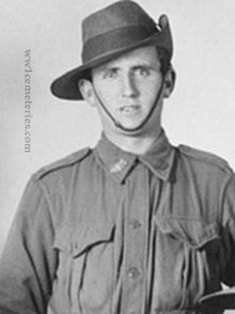
3754 Private
Joseph Peter Belleville
29th Bn. Australian Infantry, A. I. F.
Between 26th September 1917 & 27th September 1917, aged 23.
Plot XI. A. 11.
Son of John P. and Mary A. Belleville. Native of Watchem, Victoria, Australia.
Joseph Peter Belleville
29th Bn. Australian Infantry, A. I. F.
Between 26th September 1917 & 27th September 1917, aged 23.
Plot XI. A. 11.
Son of John P. and Mary A. Belleville. Native of Watchem, Victoria, Australia.

572 Sergeant
Charles Morris Greengrass
7th Bn. Australian Infantry, A. I. F.
4th October 1917, aged 24.
Plot XXIX. D. 2.
Son of George and Jane Greengrass, of 31, Stephen St., Yarraville, Victoria, Australia.
A 21 year old labourer prior to enlisting on 17 August 1914, he embarked for overseas as a Private with E Company from Melbourne on 19 October 1914 aboard HMAT Hororata. On 8 May 1915, he joined the battalion at Gallipoli where he was wounded in action three months later. After being evacuated to Egypt for medical treatment, he recovered and rejoined the battalion at Gallipoli. After the evacuation of Gallipoli, the unit trained in Egypt then proceeded to France where he was twice promoted and made Acting Sergeant. While serving in Belgium, he was killed in action at Passchendaele on 4 October 1917 and buried in the Buttes New British Cemetery, Polygon Wood, Belgium. His older brother, 1434 Corporal George William Greengrass, 14th Battalion was killed in action at Lone Pine, Gallipoli on 8 August 1915
Charles Morris Greengrass
7th Bn. Australian Infantry, A. I. F.
4th October 1917, aged 24.
Plot XXIX. D. 2.
Son of George and Jane Greengrass, of 31, Stephen St., Yarraville, Victoria, Australia.
A 21 year old labourer prior to enlisting on 17 August 1914, he embarked for overseas as a Private with E Company from Melbourne on 19 October 1914 aboard HMAT Hororata. On 8 May 1915, he joined the battalion at Gallipoli where he was wounded in action three months later. After being evacuated to Egypt for medical treatment, he recovered and rejoined the battalion at Gallipoli. After the evacuation of Gallipoli, the unit trained in Egypt then proceeded to France where he was twice promoted and made Acting Sergeant. While serving in Belgium, he was killed in action at Passchendaele on 4 October 1917 and buried in the Buttes New British Cemetery, Polygon Wood, Belgium. His older brother, 1434 Corporal George William Greengrass, 14th Battalion was killed in action at Lone Pine, Gallipoli on 8 August 1915
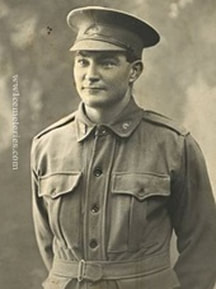
3831 Private
John Michael Benjamin Hassed
31st Bn. Australian Infantry, A. I. F.
26th September 1917, aged 26.
Plot XXIV. B. 14.
Son of John and Annie Hassed, of Morven, Queensland. Native of Bourke, New South Wales.
A labourer prior to enlistment, he embarked on 19 September 1916 aboard HMAT Seang Choon (A49) with the 9th Reinforcements. He was killed in action at Polygon Wood, Belgium.
John Michael Benjamin Hassed
31st Bn. Australian Infantry, A. I. F.
26th September 1917, aged 26.
Plot XXIV. B. 14.
Son of John and Annie Hassed, of Morven, Queensland. Native of Bourke, New South Wales.
A labourer prior to enlistment, he embarked on 19 September 1916 aboard HMAT Seang Choon (A49) with the 9th Reinforcements. He was killed in action at Polygon Wood, Belgium.

(1919) View of the area around Polygon Butte (far right) taken from Polygon Wood near Zonnebeke. On the far left are rows of stacked shells as well as duckboards, which extend across the centre. In the foreground are the remains of a sandbagged trench, in front of which are several graves marked by crosses. This panorama is one of a series taken by the Australian War Records Section with a 'Cirkut' camera.
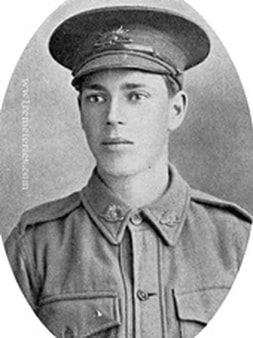
5946 Private
Frederick Thomas Hills
22nd Bn. Australian Infantry, A. I. F.
4th October 1917, aged 22.
Plot XVII. B. 18.
Son of Richard and Louisa Jane Hills. Native of Victoria, Australia.
A school teacher prior to enlisting, he embarked from Melbourne aboard HMAT Nestor (A71) on 2 October 1916. On 4 October 1917, on the front line near Passchendaele Ridge, Belgium, during the battle at Broonseinde, he was killed in action, aged 22, when struck in the chest by a bullet from a machine gun.
Frederick Thomas Hills
22nd Bn. Australian Infantry, A. I. F.
4th October 1917, aged 22.
Plot XVII. B. 18.
Son of Richard and Louisa Jane Hills. Native of Victoria, Australia.
A school teacher prior to enlisting, he embarked from Melbourne aboard HMAT Nestor (A71) on 2 October 1916. On 4 October 1917, on the front line near Passchendaele Ridge, Belgium, during the battle at Broonseinde, he was killed in action, aged 22, when struck in the chest by a bullet from a machine gun.

3504 Private
John Hunter
49th Bn. Australian Infantry, A. I. F.
26th September 1917, aged 28.
Plot I. E. 19.
The bodies of five Australian soldiers were discovered in 2006 during a pipeline excavation near Westhoek, Belgium. The Australian Government and Australian Army History Unit worked with Belgian authorities to identify the remains. Two of the soldiers - 1868 Sergeant George Calder, 51st Battalion, and Private John Hunter were identified in 2007 through DNA analysis. A third soldier, 2488 Private George Richard Storey, was identified from further DNA testing in 2008. All five were interred at Buttes New British Military Cemetery, Polygon Wood, Belgium.
John Hunter
49th Bn. Australian Infantry, A. I. F.
26th September 1917, aged 28.
Plot I. E. 19.
The bodies of five Australian soldiers were discovered in 2006 during a pipeline excavation near Westhoek, Belgium. The Australian Government and Australian Army History Unit worked with Belgian authorities to identify the remains. Two of the soldiers - 1868 Sergeant George Calder, 51st Battalion, and Private John Hunter were identified in 2007 through DNA analysis. A third soldier, 2488 Private George Richard Storey, was identified from further DNA testing in 2008. All five were interred at Buttes New British Military Cemetery, Polygon Wood, Belgium.

Second Lieutenant
Bernard Wilfrid Long
16th Bn. West Yorkshire Regiment (Prince of Wales's Own)
16th August 1917, aged 21.
Plot XXV. C. 16.
Son of Mr. D. and Mrs. M. J. Long, of the Police Station, Moseley St., Birmingham.
Bernard Wilfrid Long
16th Bn. West Yorkshire Regiment (Prince of Wales's Own)
16th August 1917, aged 21.
Plot XXV. C. 16.
Son of Mr. D. and Mrs. M. J. Long, of the Police Station, Moseley St., Birmingham.

7075 Private
Frederick McCabe
2nd Bn. Australian Infantry, A. I. F.
22nd September 1917, aged 19.
Plot XXIV. D. 9.
Son of James Warwick McCabe and Emily Maria McCabe, of Hudson St., Granville, New South Wales.
A clerk prior to enlisting, he embarked from Sydney aboard HMAT Benalla (A24) on 9 November 1916. He was killed in action at Polygon Wood, Belgium on 22 September 1917, aged 19.
Frederick McCabe
2nd Bn. Australian Infantry, A. I. F.
22nd September 1917, aged 19.
Plot XXIV. D. 9.
Son of James Warwick McCabe and Emily Maria McCabe, of Hudson St., Granville, New South Wales.
A clerk prior to enlisting, he embarked from Sydney aboard HMAT Benalla (A24) on 9 November 1916. He was killed in action at Polygon Wood, Belgium on 22 September 1917, aged 19.
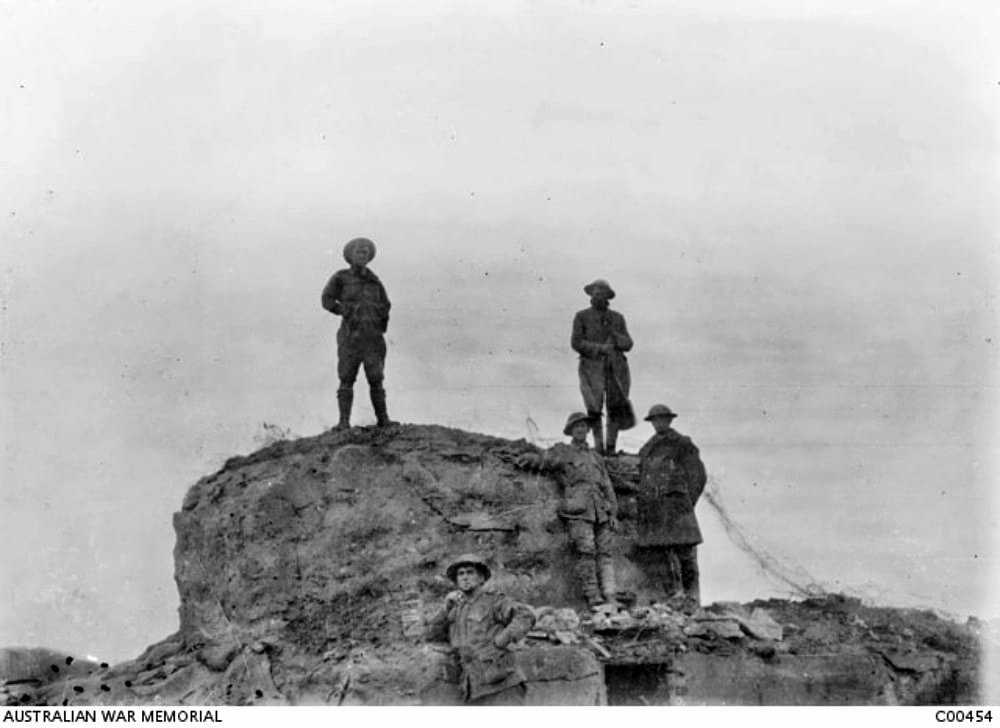
November 1917: Five unidentified soldiers standing on the pillbox (fortified observation post) known as 'Anzac House' on Anzac Ridge, near Polygon Wood in the Flemish countryside east of Ypres. The main line of German resistance lay along an old system of trenches that followed this ridge, which was attacked by the Australians during the battle of Menin Road in September 1917.
Improvised sign constructed of a thin sheet of tin nailed to a wooden post. The tin is painted white and has 'WALKING WOUNDED' stencilled on it in black paint and a red cross painted in the centre. To the right of the red cross is a single right facing red arrow indicating the direction in which the walking wounded should travel in order to receive aid. The sign its self has been damaged by shrapnel fire with a small hole on the left hand side of the cross that indicates that shrapnel pierced the sign from behind. This sign was found beside a duckboard track running back from Polygon Wood by members of the Australian War Records section in February 1919. It is associated with the Battle of Polygon Wood in September 1917 and indicated the direction walking wounded would go to receive treatment.

2456 Private
Douglas Faithful Price
59th Bn. Australian Infantry, A. I. F.
26th September 1917, aged 23.
Plot XXVIII. C. 9.
Son of David and Mary Price, of Orbost, Victoria, Australia.
A labourer prior to enlistment, he embarked with the 5th Reinforcements from Melbourne aboard HMAT Shropshire on 25 September 1916. While serving in Belgium, Pte. Price was killed in action at Polygon Wood
Douglas Faithful Price
59th Bn. Australian Infantry, A. I. F.
26th September 1917, aged 23.
Plot XXVIII. C. 9.
Son of David and Mary Price, of Orbost, Victoria, Australia.
A labourer prior to enlistment, he embarked with the 5th Reinforcements from Melbourne aboard HMAT Shropshire on 25 September 1916. While serving in Belgium, Pte. Price was killed in action at Polygon Wood

3951 Lance Corporal
William White
15th Field Coy. Australian Engineers
26th September 1917, aged 37.
Plot XXVIII. D. 9.
Son of William and Emily Jane White, of Tamworth, New South Wales.
William White
15th Field Coy. Australian Engineers
26th September 1917, aged 37.
Plot XXVIII. D. 9.
Son of William and Emily Jane White, of Tamworth, New South Wales.
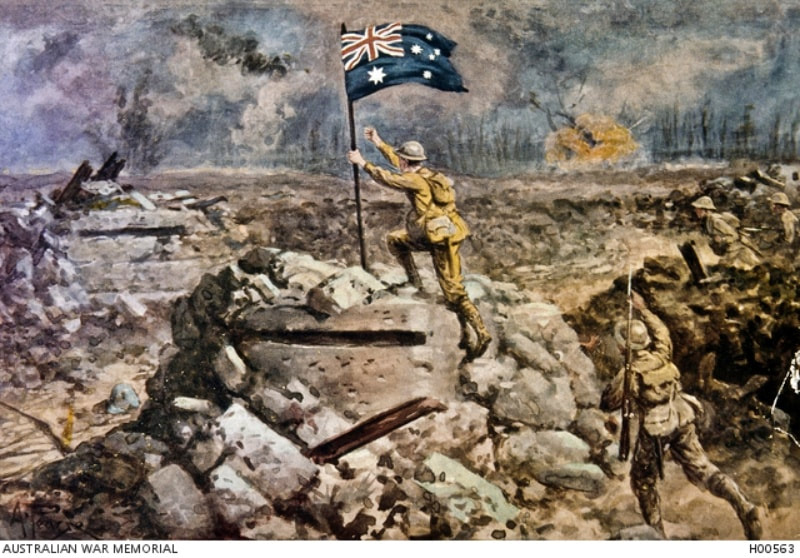
A copy of a colour printed post card of a 1917 scene on the battlefield in Belgium. The original post card was titled; "The Battle of Polygon Wood From Original Drawing by A. Pearse, War Artist." The following description was printed on the reverse of the card; "One of the most inspiring and historic events during the Battle of Polygon Wood (Belgium), was the planting of the Australian Flag on Anzac Redoubt (German Pill-box), at 7.15 a.m., on September 20th, 1917, by Lieutenant A V L Hull, 18th Battalion. He was killed in action three weeks later." This postcard was produced for sale and all profits were directed to the Australian Comforts Funds. (1920)
1918. Memorial cross to Australian servicemen killed at Polygon Wood, it is marked; "In Loving Memory of the Officers, Non Commissioned Officers and Men of the 15th Field Company, Australian Engineers, Who Were Killed in Action 26.9.1917 - 3.10.1917, A Token of Esteem From Their Comrades."
Images in this gallery © Geerhard Joos

28th September 1917: Exterior view of a captured German fortified stronghold called Garter Point located near Anzac House. At the time this stronghold marked the limit of the Australian advance during the operations near Zonnebeke and was being used as the advanced Headquarters of the 47th Battalion. An obscured soldier, probably Australian, is partially visible in the doorway of the pillbox (far left). Note a sign in the background (far right) reads 'Garter Point' and a sign on the corner of the pillbox (centre) reads 'Batt HQ'.
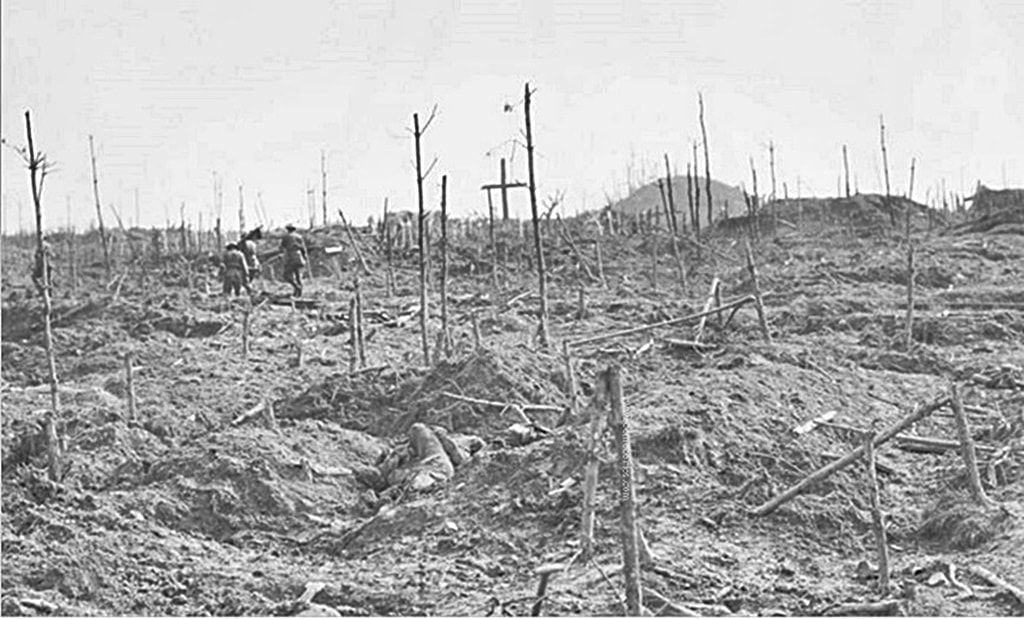
Stretcher bearers of the 57th Battalion, passing through the cemetery near the mound in Polygon Wood in the Ypres Sector. This area was subject to almost continual shellfire, the front line, then about 300 yards away, having been established only the morning before, following the attack on this vicinity by the 4th and 5th Division. (Note the bodies of those killed in the centre foreground) - 28th September 1917.

11th October 1917; This mound, which stood on the far side of Polygon Wood, was taken by the 5th Division in the Battle of that name on 26 September, despite heavy difficulties caused by the driving in of the line immediately to the south of it on 25 September. Around its slopes were thickly strewn the shell torn bodies of more than a hundred German, Australian and English troops.

